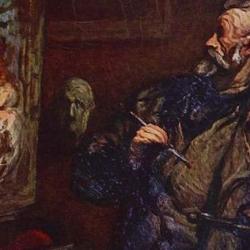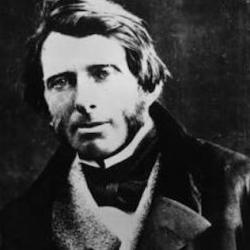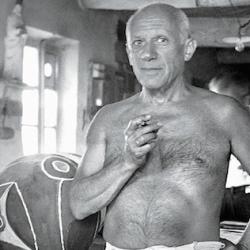“Who’s afraid of modern art?” asks Daniel Siedell. He answers, “I am.” As critic and curator, Siedell is passionately devoted to modern art. It frightens him because that is what it’s supposed to do.
Munch’s The Scream, for instance, doesn’t just express the painters own anxieties. It is “an attempt to externalize the fear that plagued him, the fear that no one could hear him scream, that what coursed through nature actually coursed through his veins, and his alone. For Munch nature became an echo chamber where his own anxiety in the fear of death could only yield a desperate, silent scream. But The Scream is Munch’s attempt to get out, to allow it to be heard, somehow, in paint and pastel.” The painting is “the sound of our response to nature’s brute silence and indifference, undisclosed as gift through God’s Word” (21).
Siedell worries that Christians soften modern art by looking at it through the diffusing lens of Christian worldview. It’s not supposed to express a worldview. It confronts “us with our own mortality, our own weakness, failure, and impending death.” Perhaps, he suggests, it’s the disquiet the painting produces, and not Munch’s “worldview,” that makes Christians recoil. We don’t want to be reminded of death and deathly silence, so we file the painting away as nihilistic instead of looking at it, receiving it (22).
Siedell knows that for Christians The Scream cannot be the last word, but “in its articulation of pain and suffering, in its diagnosis of our human condition . . . it must be the first word that we hear” (22).
Christians need to be involved in the arts, but not, Siedell insists, as Christian artists or critics—not in the sense of coming to art with a pre-arranged worldview filter. Christians should enter the art world as listeners, receivers. Christians can thrive in the world of modern art because they have been freed: “The world needs us to pay attention to the insightful art, music, film, and poetry that is already out there, the work that comes from pain, suffering, and brokenness, the world that plumbs the range of human emotion and feeling. . . . The world desperately needs us to live freely out of the grace that God gives . . . to live not as righteous culture judges, but as broken sinners bearing witness with the arts to God’s sustaining peace amidst the city.” We can have this freedom “only if we keep our sinfulness and frailty before us,” since “the remembrance of our own unrighteousness and disobedience frees us from the reactionary and defensive posture toward art and culture, allowing us to love our artistic neighbors by loving their art, poetry, music, and film. We are free to make ourselves vulnerable to art, allowing it to work on us as art” (31).
Much to affirm here for sure, but there are a few problems with the way Siedell sets things up rhetorically. We might ask, to start, what place judgment has in our experience of art. Granted, there is a moment of open receptivity; does judgment, including ethical and theological judgment, enter (as Eliot, Lewis, and many other Christian critics have claimed)? Siedell might be taken to imply that judgment—a negative judgment on “modern art”—is itself an expression of defensive self-righteousness. And if that’s the set-up, it becomes very difficult to have a discussion about the artistic (or other) value of a painting like The Scream.
Siedell is not, of course, opposed to passing judgment. He’s an art critic. He’s very harsh with Thomas Kinkade. Kinkade’s claim that he is trying to “portray a world without the Fall” becomes the ground for Siedell’s striking critique: “Kinkade has long railed against the nihilism of modern art and the contemporary art world. But because it claims to deny where we live, that is, in the midst of death and brokenness, east of Eden, Kinkade’s work is more nihilistic than anything Picasso and Pollock could paint, or Nietzsche and Sartre could write” (76).
I don’t intend to defend Kinkade, but I wonder if Siedell is consistent with his own stance: Has he been receptive to Kinkade’s vision? Is his reaction a kind of inverted self-righteousness, the defensiveness of the cynic who sees only the ugliness and pain of the world and resists the shock of its beauties? Siedell mentions Mako Fujimura in passage (60-61) but doesn’t analyze his paintings. What would he say about the golden world of Fujimura’s paintings? Lacking screams, are they sufficiently authentic? Siedell (unfairly, I think) makes much of Kinkade’s broken life. If Rublev’s Trinity turns the brokenness of the painter into hope (111), why not Kinkade? Why not see Kinkade as a glimpse of life after the eschaton?
I’m playing. But my question is a real one: If we are free from reactionary responses, free to listen and receive, shouldn’t we also be free to listen and receive this? If we want to plumb the depths of human feeling—of all human feeling—why exclude cozy feelings from our exploration? Has Siedell’s worldview intruded on the proceedings?
And that raises a more substantive question. Siedell comments modern art for being real, for not ignoring the brokenness of things. That, of course, raises the question of what reality is. Is The Scream truly the first word in the world we live in? There are times when Siedell seems to be not only attentive to the brokenness, but to ontologize it.
Pardon the world-viewishness, but the Gospel tells us we live in a world where Jesus, who is Life, reigns. Our stance to the world is a stance in Christ, in whom we are reconciled to God, and hence to the world that is His. This is not a stance of self-righteousness; it is quite the opposite of defensiveness. Modern art, like everything else, belongs to God, to Christ, and so to us (1 Corinthians 3). Precisely because we trust that He is repairing our shattered selves, we can be open, receptive, hospitable because He is and makes us so.















